By Louis Golino for CoinWeek….
What is it about curved, or cup-shaped coins, that appeals so much to collectors? Various world mints have increasingly explored issuing coins in unusual shapes such as cylinders, cubes, squares, and so forth, but none of those shapes have been as successful as the convex/concave combination.
In part it is the novelty of the concept, which so far has only been used by five world mints as far as I know, and three of them only issued their cup-shaped coins this year. It all began with the issuance in 2009 of two French coins that honored the International Year of Astronomy and the 40th anniversary of American moon landing, one in silver and another in gold. The French coins were big hits and are not easy to locate today, as very few dealers have them in stock.
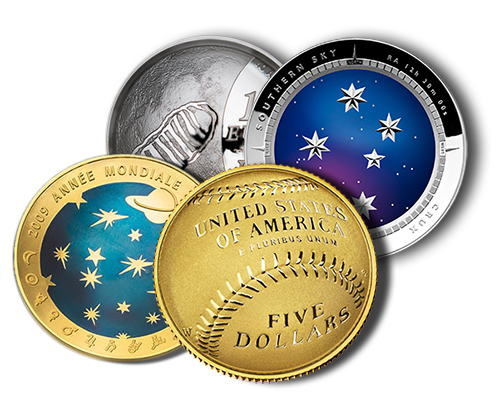 Since then a number of curved coins have been issued by world mints, and of course there are the 2014 baseball commemoratives (half dollar, dollar, and $5 gold) that were popular from the time they were first announced in part because of their unusual shape, a first for modern American issues.
Since then a number of curved coins have been issued by world mints, and of course there are the 2014 baseball commemoratives (half dollar, dollar, and $5 gold) that were popular from the time they were first announced in part because of their unusual shape, a first for modern American issues.
But the real reason the cup-shape is so popular with modern coin collectors is that it is a very effective concept when the subject matter lends itself so naturally to a convex/concave shape. The two most obvious topics that are well-suited to this approach are sports because the curved side resembles one half of a ball of whatever kind, and astronomy because the dome can also represent the surface of the earth, moon, etc., or of the sky. Geography is another area that comes to mind.
After the silver and gold French coins from 2009, the next coins with that shape were the ones issued by the Royal Australian Mint for the Southern Sky star constellations starting with the 2012 Southern Crux coin, which was the first convex/concave-shaped Australian coin. It was done with silver stars aligned to form a cross against a blue sky background and was very popular from the time it was first issued. That coin recently has been selling for $400 and more and was only around $100 when issued. It was followed in 2013 by the green-colored Pavo coin. And according to reliable sources in Australia, in late August or early September a third coin will be issued, this time for Orion. The third Australian coin was originally expected for June, but it has apparently been delayed. So far that series is probably the most popular non-American curved-shape series, and the 10,000 mintage of each coin has been easily absorbed by the world coin market.
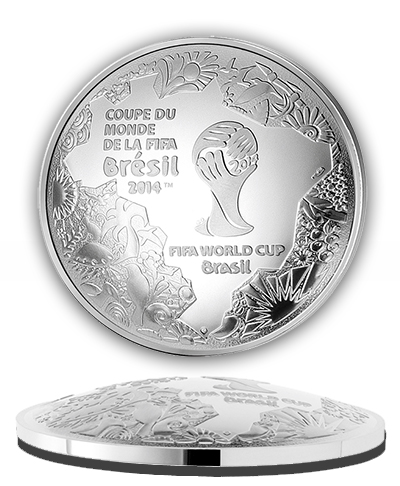 Because there are still relatively few curved coins some collectors are putting together sets of each of the ones issued so far, at least all the silver ones that is, since the gold coins are rather expensive. The 2014 American baseball coins are still $800 even after a recent dip. And even more prohibitively expensive is the French gold coin from 2009 which has a blue-colored insert and costs several thousand dollars.
Because there are still relatively few curved coins some collectors are putting together sets of each of the ones issued so far, at least all the silver ones that is, since the gold coins are rather expensive. The 2014 American baseball coins are still $800 even after a recent dip. And even more prohibitively expensive is the French gold coin from 2009 which has a blue-colored insert and costs several thousand dollars.
The three newest coins in the curved series include French coins for the 2014 FIFA World Cup soccer tournament held in Brazil, which just began on June 12 and runs through July 13, and which was issued in a 22.2 gram silver and five ounce gold version. Only the silver and a one ounce gold coin are curved but two smaller gold versions and a 5 ounce gold coin were also issued. The French Mint always issues multiple versions of the same commemorative in silver and gold. The silver soccer coin is the one most collectors are likely to purchase and has a mintage of 10,000 pieces.
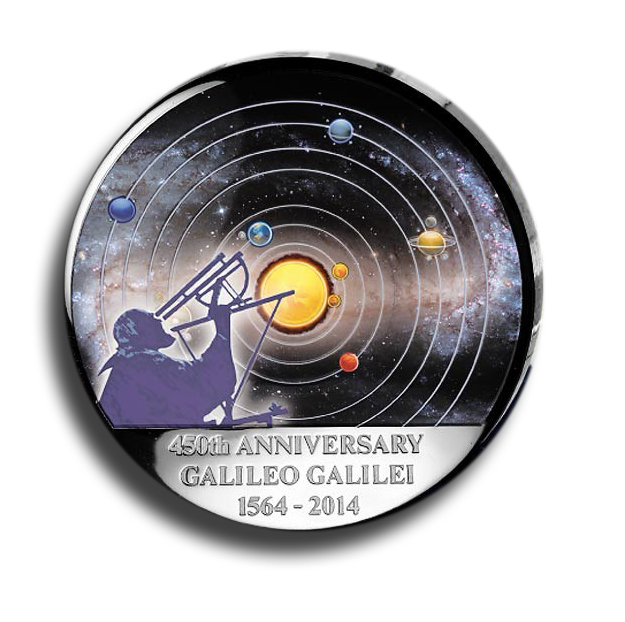 The second new curved release is a coin issued by the Congo to mark the 450th anniversary of the birth of the most famous astronomer of all time, Galileo Galilei.
The second new curved release is a coin issued by the Congo to mark the 450th anniversary of the birth of the most famous astronomer of all time, Galileo Galilei.
Born in 1564 in Pisa, Italy, he is considered the father of science, physics, and observational astronomy.
The Congo coin, which is a one-ounce silver proof with a mintage limited to 1450 and a denomination of 30 Francs, is quite striking and is already very popular.
The colored-obverse (convex side) shows Galileo peering through a telescope and also depicts the solar system, which he discovered. The reverse (concave side) shows the surface of the moon in exquisite, textured detail with the various craters and mountains shown.
The third new convex issue is from the Cook Islands and is the first issue in a new “Wonderful Mosaics” series. As one of the coin’s North American distributors, First Coin Company explains, the coin depicts in color the beautiful mosaic from the interior of a famous 13th century church in Rome: “The Papal Archbasilica of St. John Lateran, commonly known as St. John Lateran’s Archbasilica, St. John Lateran’s Basilica, and just The Lateran Basilica, is the cathedral church of the Diocese of Rome and the official ecclesiastical seat of the Bishop of Rome, who is the Pope.”
It is not unusual for world mints to pick up on a design or shape used by one of their competitors and use it on their own coinage. There are countless examples of that such as our own mint issuing large, five ounce silver coins, which is something mints around the world have been doing for years.
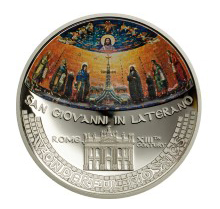 It is therefore not surprising that the dome shape would be repeated after the success of the French and Australian coins. But there is always a danger of using the same concept too much, especially when done by the same country’s mint. Many collectors have pointed out that if our Mint started issuing other coins with dome-shapes or other unusual shapes, our coinage would start to resemble what some people call the “circus coinage” of other countries, and the concept would likely become less popular if it were overused. The dome approach was a radical departure for American coins, but just radical enough without being too odd.
It is therefore not surprising that the dome shape would be repeated after the success of the French and Australian coins. But there is always a danger of using the same concept too much, especially when done by the same country’s mint. Many collectors have pointed out that if our Mint started issuing other coins with dome-shapes or other unusual shapes, our coinage would start to resemble what some people call the “circus coinage” of other countries, and the concept would likely become less popular if it were overused. The dome approach was a radical departure for American coins, but just radical enough without being too odd.
The forthcoming Football Hall of Fame coins to be issued in 2015 do not include any specific shape requirements. Although opinion is divided, most collectors seem to come down on the side of not issuing a football-shaped coin, which may not even be technologically feasible.
It is important to remember how much our mint relied on the French and Australian coins when it was preparing the baseball coins for mintage, which Mint officials have explained was so difficult that they compare it to the moon landing in the words of Steve Antonucci of the U.S. Mint, quoted in a recent Wired magazine article.
According to coin media reports, one of the first things the team developing the baseball coins did was make reproductions of the French and Australian coins so they could study the specific minting requirements of a curved coin. And the legislation that created the coins specifically required that they be issued in a concave/convex shape similar to the 2009 French coin.
For now the concept remains popular with collectors and is likely to remain that way unless it is overdone. It works because it is a very effective way to visually represent certain themes, and it seems to strike the right balance between being different enough from other coins without being too unusual. But the question remains, to use an expression my father was fond of: How much is too much of a good thing?
Copyright © CoinWeek – June 2014
***
 Louis Golino is a coin collector and numismatic writer, whose articles on coins have appeared in Coin World, Numismatic News, and a number of different coin web sites. His insightful retrospective on the American Silver Eagle was the cover feature of the February 2014 issue of The Numismatist. His column for CoinWeek, “The Coin Analyst,” covers U.S. and world coins and precious metals. He collects U.S. and European coins and is a member of the ANA,PCGS, NGC, and CAC. He has also worked for the U.S. Library of Congress and has been a syndicated columnist and news analyst on international affairs for a wide variety of newspapers and web sites.
Louis Golino is a coin collector and numismatic writer, whose articles on coins have appeared in Coin World, Numismatic News, and a number of different coin web sites. His insightful retrospective on the American Silver Eagle was the cover feature of the February 2014 issue of The Numismatist. His column for CoinWeek, “The Coin Analyst,” covers U.S. and world coins and precious metals. He collects U.S. and European coins and is a member of the ANA,PCGS, NGC, and CAC. He has also worked for the U.S. Library of Congress and has been a syndicated columnist and news analyst on international affairs for a wide variety of newspapers and web sites.


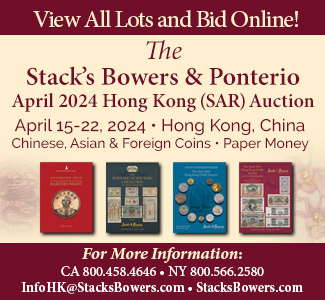


2014 Latvian “The White Book” silver commemorative coin are another unique shaped coin. Which is square shaped with slight flap on edge in one side.
I received the Congo Galileo coin today from a U.S. company that had a good price, a bit less than e-Bay sales. I am very pleased. It is really an excellent, pleasing coin in every way. The colored convex side is nicely done, and the concave side with the moon surface is truly a masterpiece with great detail. Good job, Congo mint!
Louis, great article. If you don’t mind letting me know which company you used to pick the Galileo up. I’d like to grab another and am consider dazzling coins @ 99$. I just got the Wonderful Mosaic too. Has to be one of my favorite domed pieces next to the ’09 Astronomy and BHoF silvers. Thanks
In both your article and your comment you describe the colored side of the Congo coin as “convex” and the Lunar surface side as “concave”. This is reversed.
Lou, I am doing an article on curved coins for the PAN Journal. You mention 5 mints are doing curved coins. I can only come up with 3 or 4. Can you provide them. Also your thought on the Mosaic series. The planchet is not curved. Would we still consider it in the collection. Thanks, Tom U.